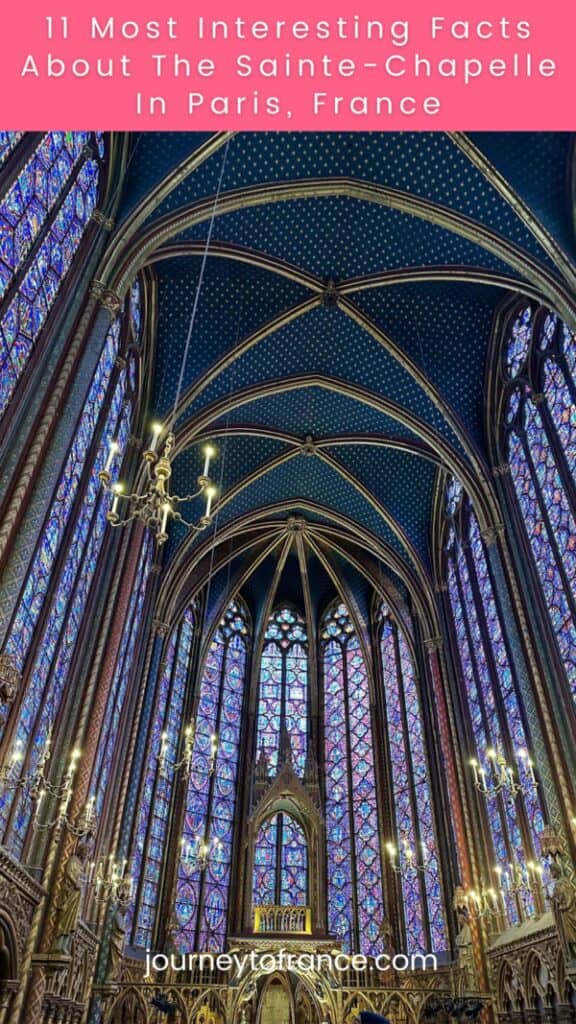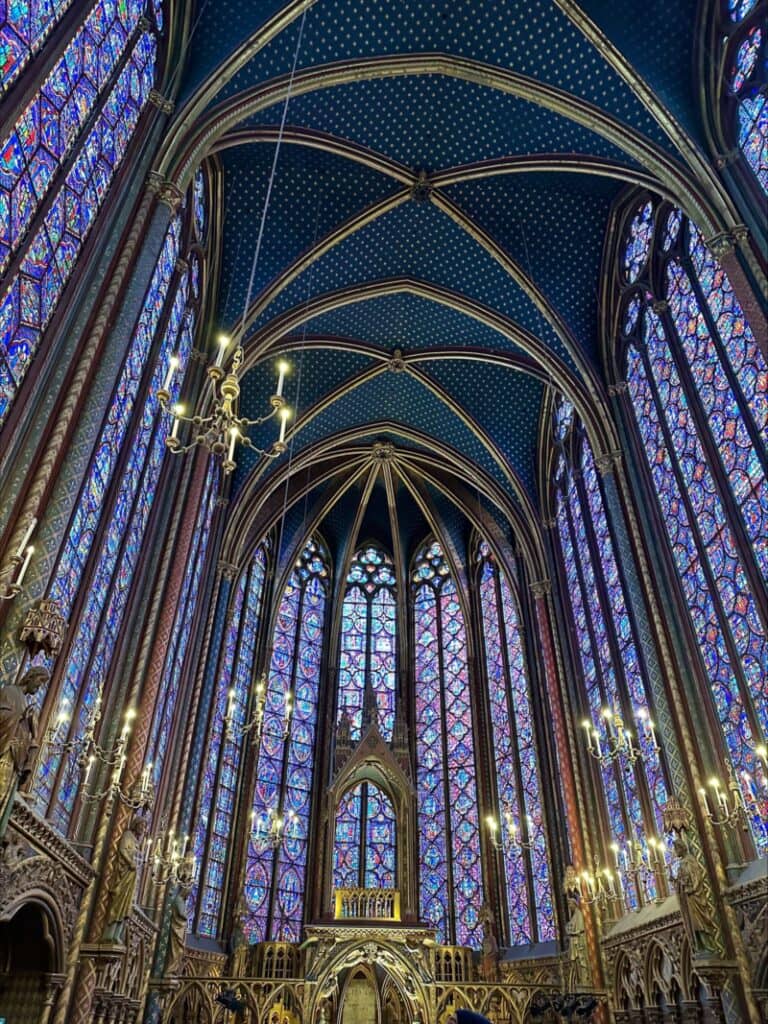Do you want to know some interesting facts about the Sainte-Chapelle?
The Sainte-Chapelle is a Gothic-style royal chapel you can find in the heart of the medieval Palais de la Cité, the former residence of the French monarchy until the 14th century. The Palais is on the Île de la Cité in the River Seine in Paris, France.
The purpose of this building was to house King Louis IX’s precious collection of religious relics, including Christ’s Crown of Thorns that he had acquired. Possessing these holy relics made King Louis IX even more powerful, becoming the head of western Christianity.
The Sainte-Chapelle is a proof of the beauty and grandeur of medieval architecture, serving as a reminder of the significant role that religion and the monarchy played in the culture and history of France.
Keep reading to learn more interesting facts about the Saint-Chapelle in Paris, France.
Things you'll find in this article
- 11 Most Interesting Facts About the Saint-Chapelle in Paris, France
- 1. The Saint-Chapelle was constructed by King Louis IX in the 13th century
- 2. The construction of the Sainte-Chapelle cost three times less than what the Crown of Thorns was worth
- 3. The relics were kept in a silver chest that also cost much more than the Saint-Chapelle itself
- 4. These relics bestowed extensive prestige on King Louis IX
- 5. The Saint-Chapelle was one of the first targets of the French Revolutionaries in 1789
- 6. Nearly every inch of the Sainte-Chapelle is covered in stunning stained glass
- 7. The Sainte-Chapelle is made up of two separate chapels
- 8. The Saint-Chapelle no longer keeps King Louis IX’s precious Christian relics
- 9. The famous Christian relics were pawned by an emperor to a Venetian bank
- 10. The Saint-Chapelle’s rose window consists of 87 petals
- 11. The Saint-Chapelle has been copied outside of France
11 Most Interesting Facts About the Saint-Chapelle in Paris, France

1. The Saint-Chapelle was constructed by King Louis IX in the 13th century
King Louis IX, also known later on as Saint Louis, had the Saint-Chapelle constructed between 1238 and 1248. The chapel was built within only seven years, which was an impressive feat.
The Saint-Chapelle is located right beside the courthouses of the Palais de Justice within the Royal Palace. The famous chapel’s architect is unknown.
The Saint-Chapelle was consecrated on the 26th of April 1248. It is regarded as one of the highest accomplishments of the Rayonnant period of Gothic architecture.
2. The construction of the Sainte-Chapelle cost three times less than what the Crown of Thorns was worth
To build the Saint-Chapelle, King Louis IX spent bout 40,000 livres tournois, which was three times smaller than the cost of the most important relic that was kept in the chapel – the Crown of Thorns.
The Crown of Thorns was bought for 135,000 livres tournois in the 1200s, which was worth about half of the royal domain’s annual income.
Despite the relatively low cost to construct the Sainte-Chapelle, it is regarded as one of the most impressive and beautiful examples of Gothic architecture not just in Paris but the whole of France.
3. The relics were kept in a silver chest that also cost much more than the Saint-Chapelle itself

The storage of these relics cost 2.5 times the amount spent on the Saint-Chapelle.
The reliquary is made of silver – the Grand-Chasse – where the relics were kept. The silver chest was large and elaborate. King Louis IX spent 100,000 livres tournois on it.
4. These relics bestowed extensive prestige on King Louis IX
The presence of the holy relics that King Louis IX had acquired made him even more powerful.
The remaining fragment of the True Cross and the Crown of Thorns, in particular, gave the French monarchy such prestige in a way that Pope Innocent IV even declared that Christ had symbolically crowned the French king with his own crown.
5. The Saint-Chapelle was one of the first targets of the French Revolutionaries in 1789

The Sainte-Chapelle plays a very important role in both French history and culture, as it was a representation of the monarchy and the power of the kings of France.
As such, it was no surprise that the famed chapel became one of the first targets of the French Revolutionaries in 1789.
The said attack devastated two-thirds of the Saint-Chapelle’s famous stained glass windows. The chapel was later restored and today remains among the most popular tourist attractions in the French capital.
6. Nearly every inch of the Sainte-Chapelle is covered in stunning stained glass
The distinctive architecture of the Sainte-Chapelle is identified by its maximum amount of illumination and stunning stained glass windows that create a dramatic visual effect.
Although constructed by the French king to house his collection of Christian relics, the Sainte-Chapelle today is visited for the beauty of its stained glass windows, which are among the most splendid in the world.
Almost every single inch of the famous chapel is covered in stunning stained glass.
The Sainte-Chapelle has 15 windows, each measuring around 50 feet in height, and within which are 1,113 Biblical scenes derived from the Old and New Testaments.
These scenes illustrate the story of the Bible and how the precious relics made their way to Paris.
7. The Sainte-Chapelle is made up of two separate chapels

The chapel comprises of two chapels: the lower chapel and the upper chapel, each having distinct features albeit equal in size.
The lower chapel, dedicated to the Blessed Virgin Mary, was originally allocated to the non-royal officers of the neighboring Royal Palace.
The upper chapel, on the other hand, was custom built for the French king and the royal family. The upper chapel consists of glass that is 618 square meters in size and with a delightful combination of lightness and balance. The upper chapel is where the 1,130 biblical figures are depicted.
The lower chapel’s original stained glass was destructed by a flood in the late 17th century. It was replaced by colorless glass.
Both chapels were completely restored in the 1800s.
8. The Saint-Chapelle no longer keeps King Louis IX’s precious Christian relics

While King Louis IX originally acquired 22 sacred relics, only three of them are left today. There is still a fragment of the cross where Jesus was crucified, a nail, and the most important – the Crown of Thorns.
These religious relics are no longer housed in the Saint-Chapelle, instead they are now part of the Notre-Dame de Paris treasure.
The original relics were believed to have included the Blood of Christ, the Holy Cross, the Holy Crown, the Holy Shroud, the rod of Moses, hair that belonged to Mary (Jesus’ mother) and pieces of her veil, a spearhead, and pieces of nails.
9. The famous Christian relics were pawned by an emperor to a Venetian bank
King Louis IX built the Sainte-Chapelle within his royal palace in Paris to house the 22 original relics he had obtained. These relics were originally from Emperor Baudouin II of Constantinople (modern-day Turkey). He had pawned the sacred relics to a Venetian bank, where the future Saint Louis bought them.
Emperor Baudouin II was Constantinople’s last Latin emperor. In his desperation to come up with funds to rebuild his besieged city, the emperor pawnee the holy relics to a Venetian bank.
10. The Saint-Chapelle’s rose window consists of 87 petals

The stained glass window called the “rose window,” which is a part of the Saint-Chapelle, has 87 petals. This stained glass is younger than the Saint-Chapelle, dating from the 1400s, not from the 13th century.
11. The Saint-Chapelle has been copied outside of France
The Saint-Chapelle’s fame extended beyond France, along with King Louis IX’s influence.
Important replicas of the famous chapel have been made in different locations in Europe.
These include the Collegiate Church of the Holy Cross and St. Bartholomew in Wrocław, Poland, which was built in 1350; the Karlštejn Castle near Prague, Czech Republic, built in 1360; the Hofburgkapelle in Vienna, Austria, which was consecrated in 1449; and Exeter College in Oxford, England, which was built in 1860.
These copies only sealed the high status of King Louis IX, or Saint Louis, among Europe’s aristocracy.

Hi, I’m Christine – a full-time traveler and career woman. Although I’m from the Philippines, my location independent career took me to over 40 countries and lived in 4 continents in the last 10 years, including France. A self-proclaimed Francophile, I love everything France.
